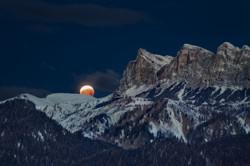Glossarbegriffe: Mondfinsternis
Description: Eine Mondfinsternis entsteht, wenn der Mond in den Schatten der Erde eintritt. Eine Mondfinsternis kann nur dann eintreten, wenn die Sonne, die Erde und der Mond hinreichend genau auf einer Linie liegen. Dabei befindet sich die Erde direkt zwischen Sonne und Mond. Daher kann eine Mondfinsternis nur in einer Vollmondnacht stattfinden. Eine totale Mondfinsternis tritt auf, wenn sich der Mond vollständig im Schatten der Erde befindet. Eine partielle Mondfinsternis tritt auf, wenn der Mond nur teilweise vom Erdschatten bedeckt ist. Die Art und Länge einer Mondfinsternis hängt von der genauen Position des Mondes auf seiner Umlaufbahn um die Erde zum Zeitpunkt der Finsternis ab.
Zugehörige Glossarbegriffe:
See this term in other languages
Term and definition status: The original definition of this term in English have been approved by a research astronomer and a teacher The translation of this term and its definition is still awaiting approval
The OAE Multilingual Glossary is a project of the IAU Office of Astronomy for Education (OAE) in collaboration with the IAU Office of Astronomy Outreach (OAO). The terms and definitions were chosen, written and reviewed by a collective effort from the OAE, the OAE Centers and Nodes, the OAE National Astronomy Education Coordinators (NAECs) and other volunteers. You can find a full list of credits here. All glossary terms and their definitions are released under a Creative Commons CC BY-4.0 license and should be credited to "IAU OAE".
Zugehörige Medien
The Eclipse Between Us, by Muhammad Rayhan, Indonesia
Bildnachweis: Muhammad Rayhan/IAU OAE
License: CC-BY-4.0 Creative Commons Namensnennung 4.0 International (CC BY 4.0) icons
The eclipsed Moon sets near the Rochetta di Prendera, Dolomiti Unesco, by Alessandra Masi, Italy
Bildnachweis: Alessandra Masi/IAU OAE
License: CC-BY-4.0 Creative Commons Namensnennung 4.0 International (CC BY 4.0) icons










